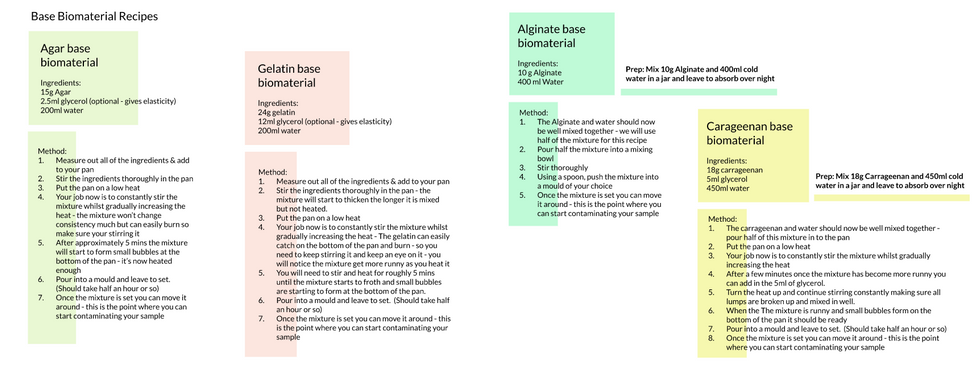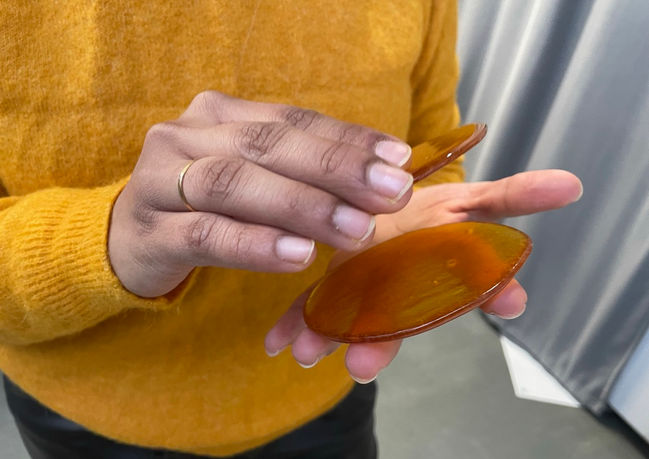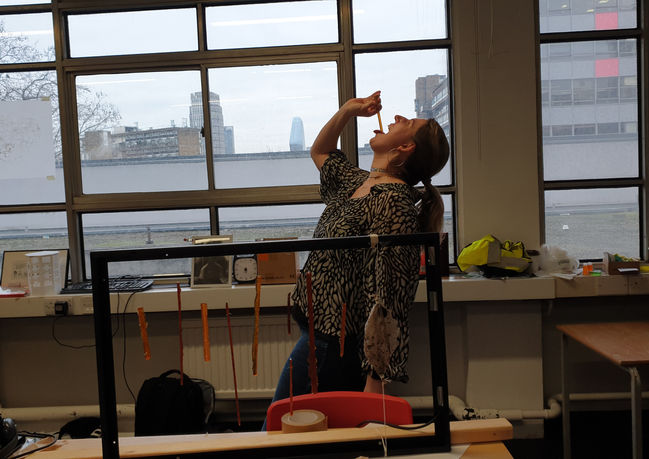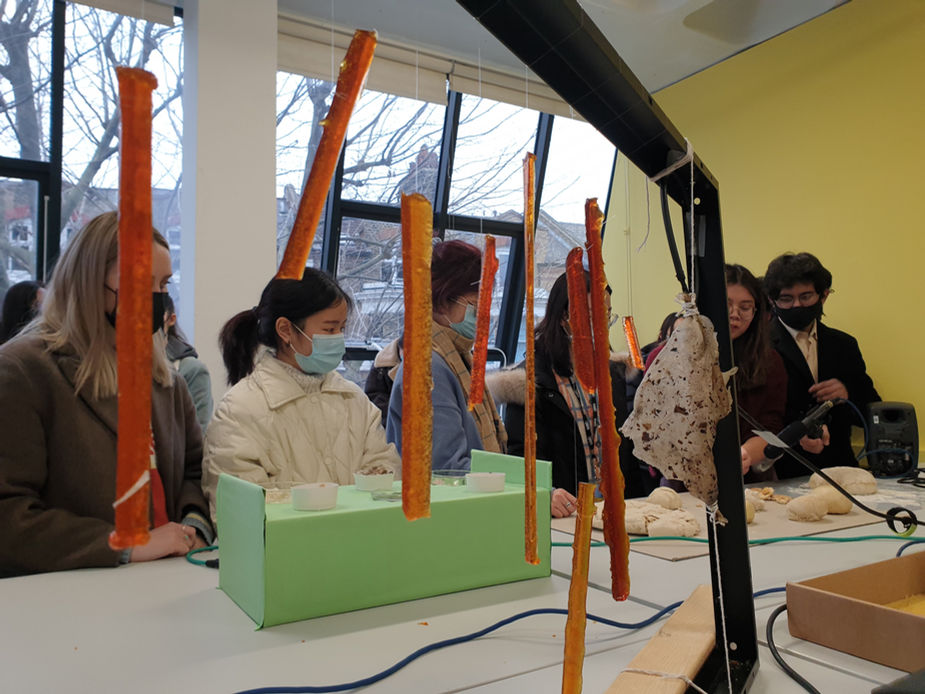top of page

Bio - Symphony
17 Jan - 21 Jan
Back To Top
Design Breif
Design and make a biomaterial instrument and play it together
Team

Introduction
There is no waste in nature yet our planet is drowning in humanities pollution. Our obsolescence culture has resulted in a climate emergency, can design make a difference with their critical approach towards human and non-human relationships and interdependency? With this question in mind, we were inspired by how designers are making use of waste and bio-materials to replenish what's taken from the world.

Research through making of bio-materials
We began our journey by exploring and playing around with the basic bio-material recipe shared by Anoushka Cole, Material Researcher, Artist & Illustrator, Material Lab Curator. The aim was to understand the materialistic nature of the bio-materials made out of Agar, Gelatin and Alginate. In many of our trials alginate never got solidified and sometimes adding too much Glycol with Agar made it gelly like.


"We were blown away by the materialistic transformation of different biomaterial recipes."
Exploring contamination and environmental change
Bacteria are an important part of our lives. We all might have seen how milk changes to curd yoghurt cultures bacteria. To discover and leverage how bio-materials change when subjected to various contaminations within different varying environmental conditions, we set out to add bread pieces, potato starch, tomatoes, turmeric, milk, curd, soil and so on. Later, we put them through extreme hot, extreme cold, windy and closed conditions to experience the delta.


"In the meantime, we were playing with sounds recorded from contact mics on countless surfaces"
Analyzing change after contamination and playfulness of material
Interestingly alginate-based liquid never became solid for us even after keeping it for a day. While Agar-Agar and other materials showed solid or stretchy outcomes based on the amount of glycerol added into it. While we saw that adding bread pieces resulted in rapid organic bacterial growth over time. Notably, Gelatin based solutions were resembling second skin once a thin layer of it was dried on a piece of cloth.
Agar - Agar transformations




Gelatin transformation

Alginate transformation
Self critique and reflection
Within the hustle of technical and time limitations, this 1 week's project put me into a real thought of understanding digital humans as powerful warriors of social & political change than capitalistic puppets. Our mission in this project was to make people experience that they are more than their bodies, limitations and scars. I personally believed that we don't need one violet avatar in silos, rather everyone turns themselves into their own form of violet energy championing self-healing and recovery culture in society.
I felt that this critical message got lost somewhere in the playfulness of the experience and didn't really evoke the sense of liberation beyond the body with violet energy. We should have given more direct context in our narrations and could have played around with body morphism during animal sound interactions.
I envision the future of violet as a digital and physical mix incarnation, situated within a playful space, unravelling violet energy in people to heal mental trauma and health challenges with happiness.

Drowning into microscopic changes
We peeped into the changes carried out within our biological materials and began to think about the leverage points to produce unique sounds.


"Here we start to hear the unheard sound with
different materials at different stages"
Experimenting with sound
Inspired by Ronnie Deelen's sound design presentation, we started crushing, folding, beating, throwing and rubbing the materials to pick up sound vibrations using contact mics and an H4N recorder. While to overcome the limitations of sound amplification and waterproofing of contact mics, we borrowed an audio mixer with insulated sound mics.

----
Building the instrument
We then conceptualized cardboard mounted instrument to have a deep sound with different materials sitting on top of it played with various gestures. While some of the high pitch sound-making elements were planned to be hung on a metal frame.

Feedback from Ronnie Deelen on our instrument
Don't try to focus on building the best instrument.
Avoid using cardboard, it dominates over the original sound of material.
Shift focus from drums and play around with materials properties.
Course correcting design directions
We all felt Ronnie's input were critical and hence we began to design an instrument that allows the free-flowing original sound of the materials. We used sounds like hitting and breaking sugar sticks, flapping of a thick Agar base and slapping of the Gelatin based skin as the unique sound for our instrument.

Course correcting design directions
We all felt Ronnie's input were critical and hence we began to design an instrument that allows the free-flowing original sound of the materials. We used sounds like hitting and breaking sugar sticks, flapping of a thick Agar base and slapping of the Gelatin based skin as the unique sound for our instrument.
Symphony on the presentation day
On the day of the presentation, we were all geared up with our costumes and instruments. Ronnie connected all the contact mics with his mixer to adjust the intensity of the sound. A few minutes later we were all playing our uniquely built bio-material instrument in the symphony.

Presentation
Self critique and reflection
This week's bio-symphony project pushed me to think about designers' critical responsibilities towards society and ecology. On one hand, It made me realize how Human-Centered Design fails to embrace the tentacular interdependent life of humans and non-humans creating a significant impact on our living planet. While on the other hand, it gave me hope of replenishing life with substitutes like bio-materials replacing unhealthy and non-sustainable materials.
The bacterial explorative materiality nudged me to rethink design methods embracing learning by making with circular systemic thinking. Additionally, the music out of such materials reflected on cohesive relationship of micro and macro-level changes. Changing our mindset won't be easy and it will have its own struggle just like I was struggling between the dilemma of noise and music of materials.
As a UX designer, it aided me to envision a new design culture entangled between capitalism, ecology and ethics accounting for every equally important life on earth.
bottom of page

































































.png)